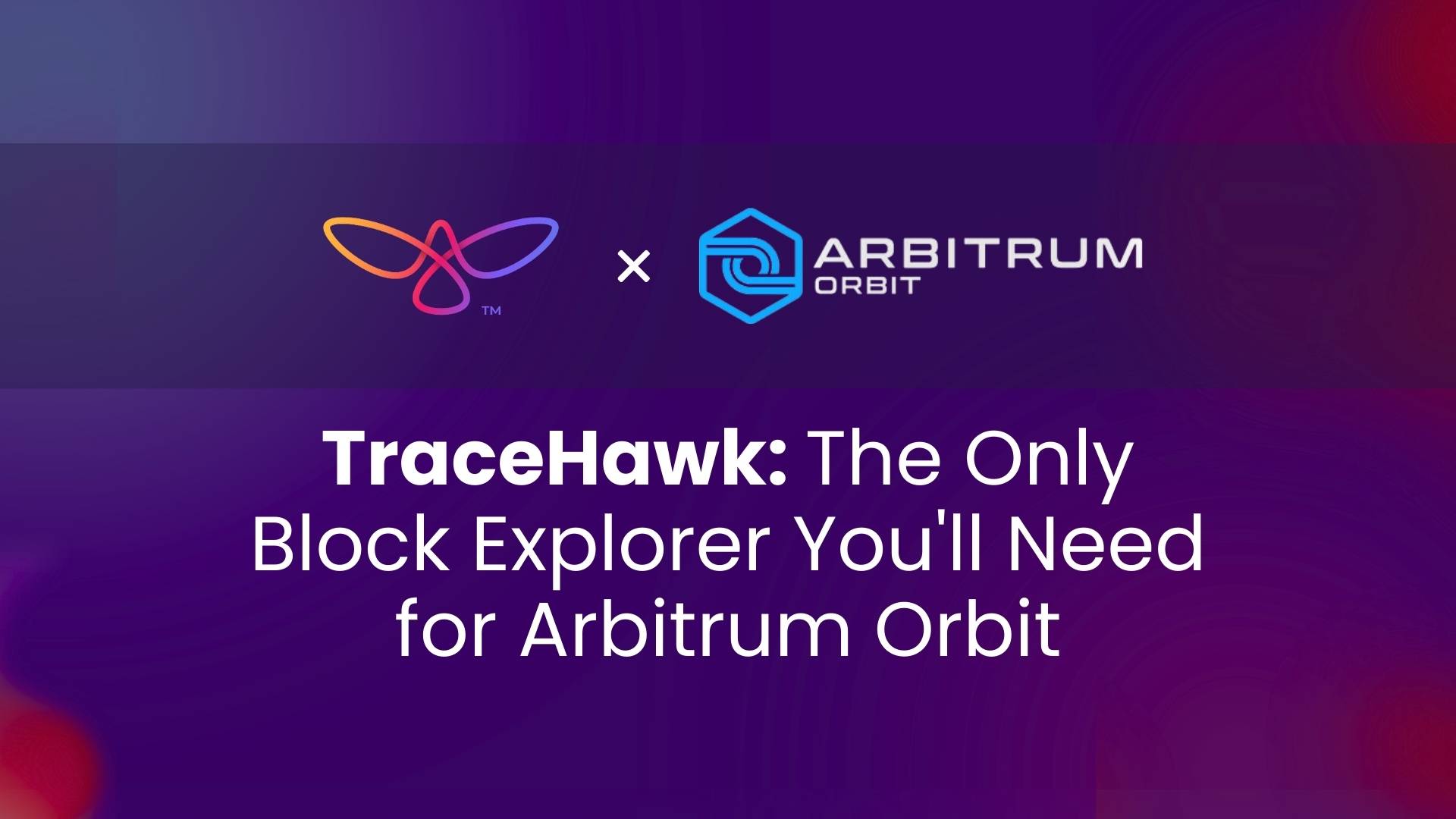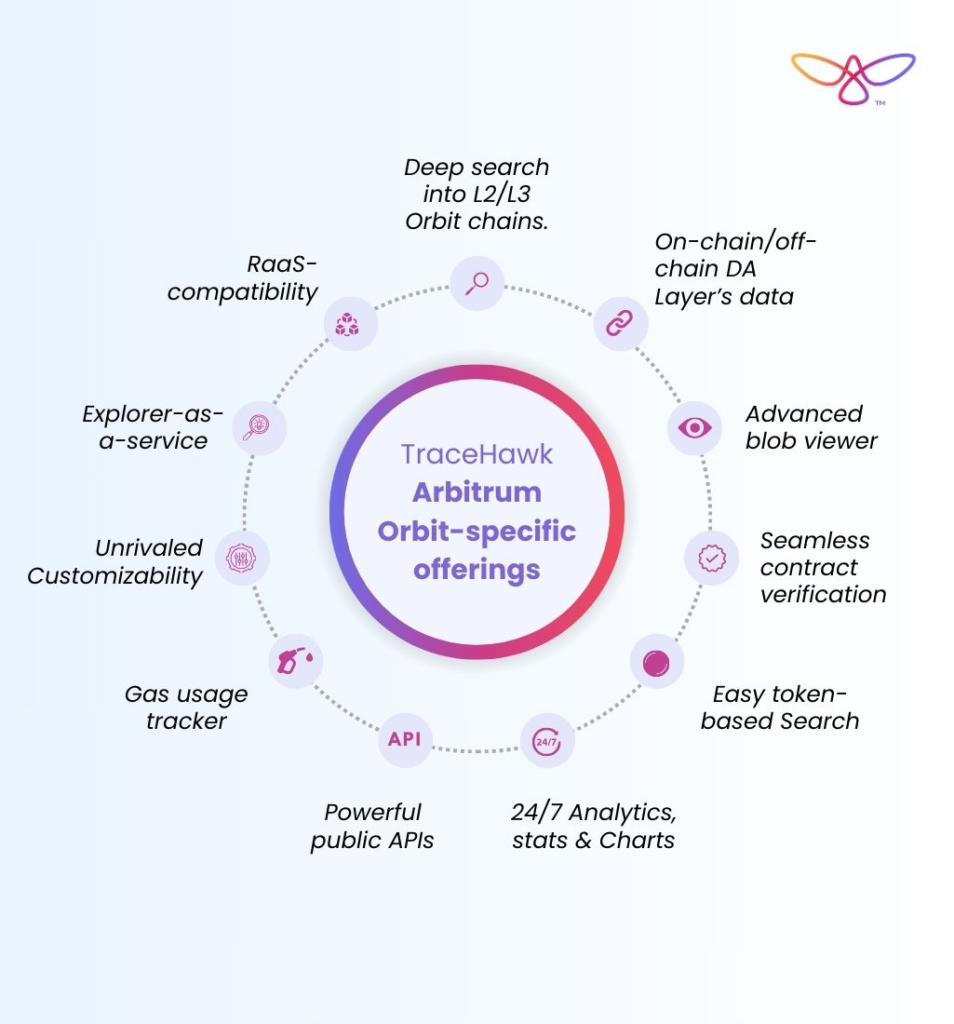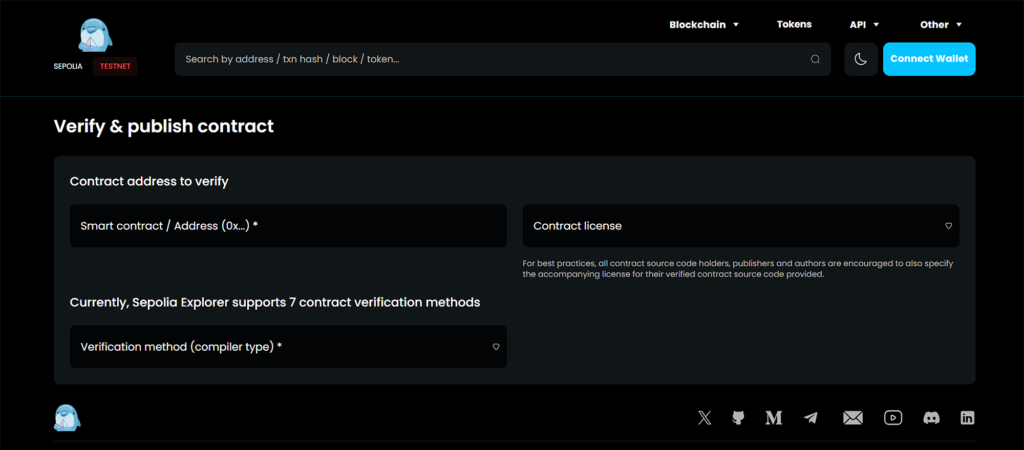Why TraceHawk is the Only Block Explorer You'll Need for Arbitrum Orbit?


Rollups are distinct from L2 protocols, and so is their need for a block explorer. TraceHawk recognized the unique capabilities of an explorer designed especially to serve L2/L3 rollups. That’s why, after the successful launch of the OP Stack explorer, TraceHawk is stoked again to offer a block explorer for Arbitrum Orbit. The decision to roll out an Orbit-specific rollup is also due to the rising demand for Orbit chains, leading to the development of 40+ chains spanning across web3 gaming, DeFi, NFTs, RWA, and socialFi.
In this article, we will dive into the core offerings of TraceHawk Block explorer for Arbitrum Orbit. Basically, we’ll understand how custom block explorers are accommodating various rollups and what makes TraceHawk a specialized block explorer for L3 Orbit chains. And, if you want to learn about end-to-end details about TraceHawk, refer to its intro article linked here:
Introducing TraceHawk: A Full-suite Multi-ecosystem Block Explorer
Arbitrum Orbit, powered by Nitro rollups technology, offers innovative features such as on-demand scalability, custom gas token, modular data availability (DA), EIP-4844 support, and self-governance. Hence, a block explorer accommodating Orbit chains must be optimized to support all these next-gen features. With general-purpose explorers, users may come across challenges in getting the interactive data from Layer3, fetching bobs’ details, exploring off-chain DA layers, and more. Knowing this, block explorers nowadays are offering independent explorers that are created for Arbitrum Orbit chains. TraceHawk is one among them.

TraceHawk offers a range of features that are uniquely designed to support Arbitrum Orbit chains, including the following:
TraceHawk allows users to delve deeper into L3 Arbitrum Orbit chains, providing them with the following main data;
Arbitrum Orbit utilizes Optimistic rollup technology, thus allowing rollup chains to publish batched transactions either on Layer1 or across off-chain DA layers like Celestia, NEAR DA, or Eigen DA. With TraceHawk, users can retrieve an interactive list of batched transactions from Layer1 as well as off-chain DA layer in a snap.
EIP-4844 introduces a cheaper and more reliable way for Arbitrum Orbit L2s to post transactions on Layer 1. TraceHawk, being at the forefront of EIB-4844 or blob support, provides users with easy access to retrieval of blob-specific transactions quickly via explorer’s interface.
Using TraceHawk explorer, users can verify and publish smart contracts in simple steps. Once verified, source code for all the contracts becomes accessible and independently verifiable. This creates enhanced transparency for users, and convenience for developers on Arbitrum Orbit to interact with and utilize the smart contract as needed.
As you can see in the image below, contract verification requires you to provide the smart contract address, contract license, and your preferred verification method. Provide all this information and continue to verify & publish a contract.

TraceHawk explorer for Arbitrum Orbit is integrated with an advanced token explorer that provides users with in-depth insights into ERC tokens. Speaking about Orbit, it will show details of $ARB token, such as token balance, total transactions, token balance, and other data of a certain smart contract. However, TraceHawk supports all the relevant ERC tokens; ERC-20, ERC- 721, ERC- 1155, ERC- 404.
Stay updated with real-time performance of your Orbit chain’s performance and updates. Leverage TraceHawk’s 24/7 analytics, statistics, and graphical charts to get the following data:
TraceHawk Block explorer for Arbitrum Orbit is equipped with powerful publicly accessible APIs that developers can use to retrieve on-chain and relevant metadata data quickly via HTTP requests. The two highly feasible and widely used APIs– Rest and Graph APIs are currently available to enable seamless data interactions.
TraceHawk comes with a robust gas tracker feature that shows crucial updates on gas prices, such as per transaction cost (during fast, average, and slow network speed), average gas fee, and historical trends on contracts’ gas consumption via heat maps & charts. Seamless tracking allows users to get an in-depth view of a network’s gas consumption while enabling chain developers to further optimize the ecosystem for cost-effectiveness and performance.
TraceHawk is built to serve as a personalized block explorer for all kinds of rollups, including Arbitrum Orbit chains. Therefore, enterprise developers have the freedom to tailor theirTraceHawk explorer’s user interface to suit use case-specific custom search, such as tags, watchlist, tokens, and more.
With TraceHawk’s EaaS, Arbitrum Orbit L3 chains get their fully-hosted and fully-managed block explorers. All the heavy lifting– be it infrastructure maintenance, ensuring top-notch performance or adding optimizations as per the future requirements, will be handled on TraceHawk’s end so that Orbit chains can focus on other important aspects of their ecosystem.
TraceHawk is designed to be effortlessly optimized according to the distinct specializations and processes of Rollups-as-a-service (RaaS) providers. RaaS providers offering Arbitrum Orbit support can include TraceHawk as the default explorer in their stack. Further, once deployed, orbit chains can customize their explorer to offer specific functionalities.
TraceHawk Block explorer for Arbitrum Orbit is ready to cater the needs of diverse web3 projects that seek to unlock a whole new experience of interacting and retrieving data from L3 ecosystems. Note that, the features and benefits discussed in this article represent TraceHawk’s main offerings. Besides this, TraceHawk supports endless customization to match your project’s requirements. If you are building or planning to build a Layer3 Orbit chain, contact us to get your personalized browser at significantly lower cost with rapid launch. Also, if you have any sort of query related to TraceHawk or its rollups-centric capabilities, feel free to mail us your concerns or get on a one-to-one call with our experts.
